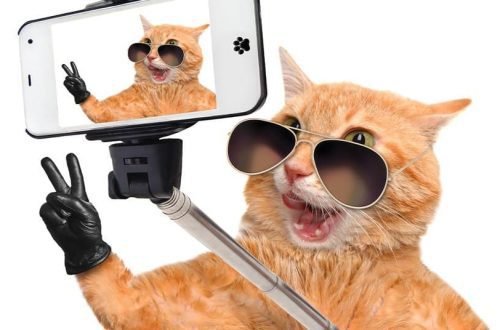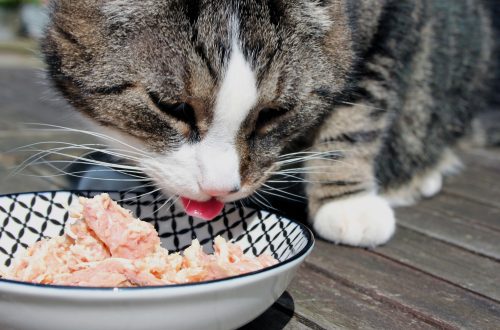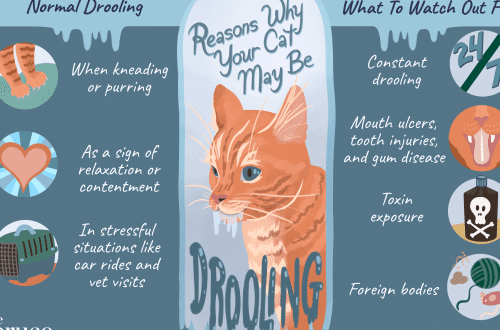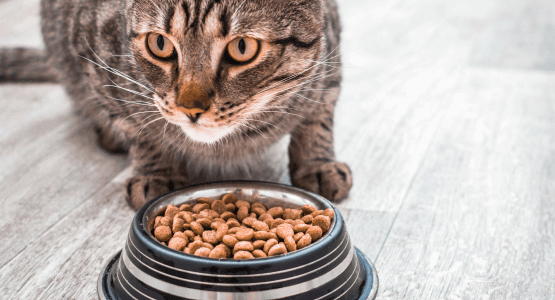
Cat food classes: lists, ratings, differences, prices
Contents
General information
In the cat food industry, these products are usually divided into four grades: economy, premium, super-premium and holistic (Human Grade). The last type of elite nutrition appeared on the pet food market not so long ago, and almost instantly eclipsed all its predecessors.
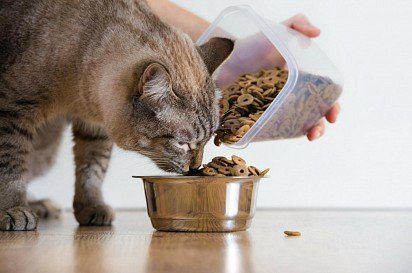
The health of your cat depends largely on choosing the right food.
The classification of feeds is rather arbitrary, since the boundaries between the products of the economy and premium, premium and super-premium, super-premium and holistic groups are not clearly marked. In Europe, the USA, Canada, there are a number of organizations involved in the certification of feed and responsible for their safety. In Russia, a similar function is performed by the Roskachestvo organization. At the moment, experts from the Russian institution recognized only three samples of cat food as high-quality products – Acana and Orijen (Canada), as well as Brit (Czech Republic).
Actually, the class of cat food depends on the category of initial meat products, their percentage, vitamin palette, the amount and variety of mineral substances contained, and the degree of digestibility of useful components.
About 80% of the cat food market is dry food. At first glance, crunchy kibbles and “pads” seem like a rather poor food, and inexperienced owners of mustachioed striped eaters often use “crackers” as a supplement to their main meal. However, high-quality balanced dry food and water is a completely self-sufficient menu for daily feeding of a pet. True, we are talking about a complete feed – such a definition should be indicated on the product packaging. Also, the norms of daily consumption, depending on the weight and age of the cat, should be indicated.
Wet food, which is delicious meat cubes in jelly or sauce, pates, is sold packaged in jars, bags, pouches of various textures. Such a product is more expensive than dry. Cats eat it with great pleasure, however, not all types of such food are suitable as a staple food and are often used as a treat or in combination with dry granules. For daily meals, you can use a range of wet foods, which include cereals, as well as vitamins K, A, D, E, taurine, iron, copper, manganese, zinc, omega-3 and omega-6 amino acids. Information must be placed on such products confirming that the food is balanced and recommended for daily diet. Complete feeds are usually sold under the brand name of manufacturers that produce both dry and wet food options for animals.
Economy feed
In most cases, economy-class food is bought for their pets by owners who blindly trust the ubiquitous advertising praising this product, as well as those who are forced to save money. Experts advise not to get too carried away with such food and compare it with instant soup. If your kitty eats such food for a long time, she will certainly have problems with the gastrointestinal tract.
The basis of the composition of economy-class feeds are the cheapest cereals, and often it is not even specified which ones. Sometimes in the list of ingredients there is a very vague and vague wording: “cereals and products of plant origin.” As a rule, such a generalizing definition simply hides the waste products of the food industry with minimal nutritional value.
You can guess the quality of the meat component of the feed by finding the phrases “poultry meal”, “meat and its derivatives”, “meal of animal origin” in the list of ingredients. Such products are meat waste (ground and processed beaks, skin, claws, hooves, offal and even tumors), and they are not too rich in protein. The main source of protein in this product is vegetable components, mainly corn gluten (gluten), vegetable protein extracts, which are extremely poorly absorbed by the cat’s body. Vitamins and minerals are also poorly represented in economy class feeds. In addition, dyes, antioxidants, preservatives, and flavors are widely used in such products, the origin of which is not specified, which suggests that they are not of natural, but of artificial origin.
In a word, such food cannot be called complete and self-sufficient in any way, but cats that eat natural products can be offered as a treat as an exception. For this purpose, fragrant wet food is best suited.
For many, economy-class foods are associated only with the widely advertised brands Friskies, Whiskas, Kitekat, Gourmet and Felix. But economical owners who care about the health of their pets should know that there are other products, for example:
- Cat Chow (produced in the USA, Russia, Hungary);
- Gemon (made in Italy);
- Purina One (manufactured in the USA, France, Italy, Russia);
- Stout (produced in Russia);
- Perfect Fit (produced in the USA, Germany, Hungary, Russia).
It is worth noting that most of the economy class feeds, namely Felix, Friskies, Gourmet, Cat Chow, Pro Plan and Purina One, are produced by one company Nestle Purina Pat Care under different brands.
Feed in this category is sold at a price of 160-380 rubles per 1 kg.
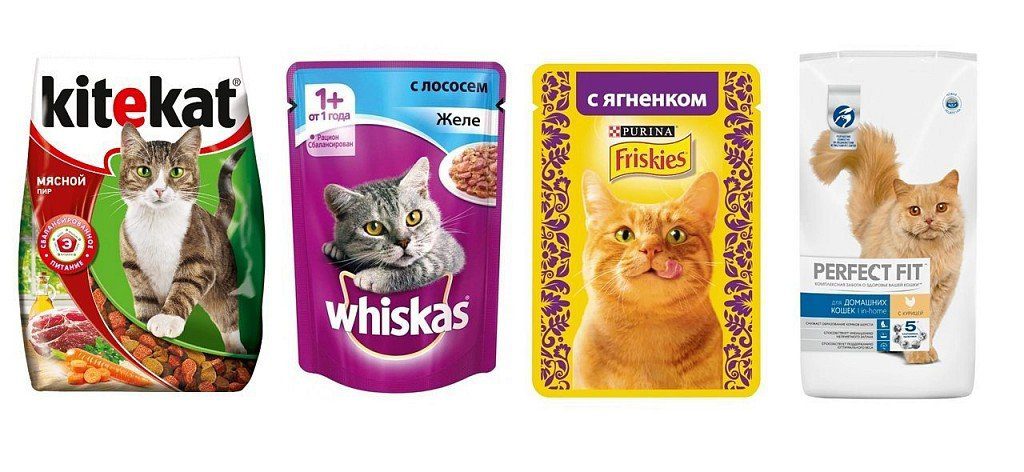
Economy class cat food is a set of by-products of category II (production waste), which allows you to reduce the price
Premium feed
Premium food in terms of quality and price differs from economy class products not so dramatically, but the word “premium” itself impresses the owners of mustachioed pets. However, they should be aware that the meat component of such feeds is also dominated by processed waste products, and the source of carbohydrates is usually corn and wheat, which often cause allergies in animals.
In fairness, we note that the presence of the meat component here is higher than in economy class feeds. Accordingly, the amount of protein of animal origin increases, which contributes to better digestibility of food. The vitamin-mineral group is more widely represented in these products, although the origin of preservatives and antioxidants is also traditionally shrouded in mystery.
Feeds of this class occupy a middle position between economy and super-premium goods. Some manufacturers focus on cheaper components of the composition, others use ingredients that are typical for products of a higher class. This explains the heterogeneity of the range of premium foods, which should make cat owners more meticulously look at the information on the composition of the product placed on the package. In terms of price / quality ratio, the following feeds look the most attractive:
- Brit Premium (produced in the Czech Republic);
- Organix (produced in the Netherlands);
- Probalance (produced in Russia);
- Hill’s (manufactured in the US and the Netherlands);
- Eukanuba (produced in Russia);
- Science Plan (produced in the Netherlands, Czech Republic).
Thanks to relentless advertising, foods such as Pro Plan and Royal Canin have also gained wide popularity. They are no better and no worse than the above brands, however, judging by the reviews, their prices are unreasonably high.
On average, premium feed prices range from 170-480 rubles per 1 kg.
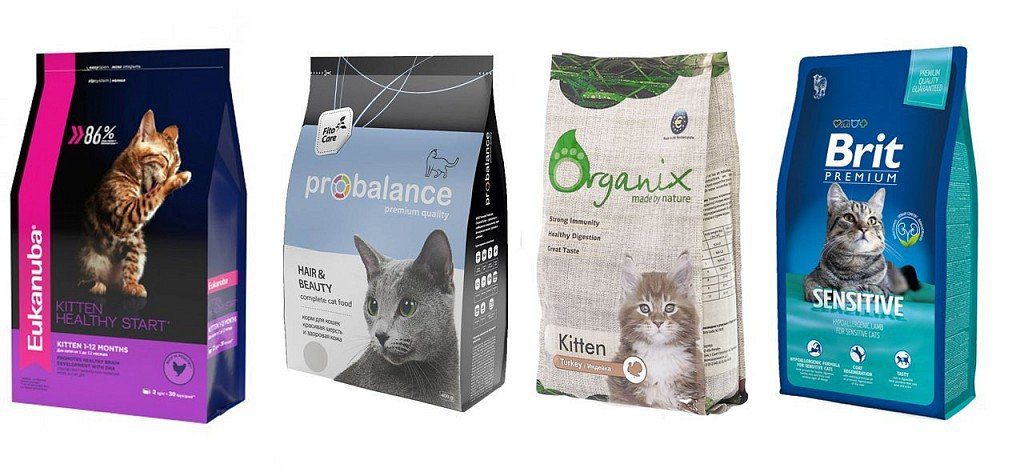
Premium cat foods are balanced in terms of vitamins and minerals and have high nutritional properties, they no longer contain chemical additives, but they are also made from by-products
The main advantage of this elite category of feed is that the main “supplier” of protein in them is animal products, not plant origin, which ensures easy digestibility of food by the animal’s body. The meat component here is represented directly by meat of the first category, as well as by-products in the form of the liver, tongue, kidneys, and heart.
Cereals are mainly rice and oats, sometimes barley, potatoes may be present in the composition. These components are easily digestible, they are not as allergenic as corn and wheat, which are obsessively present in economy and premium class products. Corn gluten, which is increasingly being blamed for causing allergies in cats, is missing.
Flavoring additives in super-premium class feeds are banned, but the vitamin and mineral palette is presented impressively. Vitamin E and rosemary derivatives are used as natural antioxidants and preservatives. If the list of ingredients does not contain information about the origin of preservatives and antioxidants, the food is unlikely to be correctly characterized as a super-premium product.
The feed of this elite category is approximately similar in quality. Differences can manifest themselves in the percentage of meat components, a set of cereals. In the ranking of super-premium cat food, which reflects the most expressive price / quality ratio, the following five stand out:
- Fitmin For Life (produced in the Czech Republic);
- Brit Care (produced in the Czech Republic);
- Summit (manufactured in Canada);
- Blitz (produced in Russia);
- Leonardo (made in Germany).
The cost of products of this class is from 180 to 550 rubles per 1 kg.
In the category of super-premium food products, medicinal and dietary feeds occupy a separate position. They are introduced into the diet of cats as directed by a veterinarian. These specific products also include hypoallergenic foods, which are divided into several types depending on which product causes an allergic reaction in the animal.
For cats suffering from an allergy to vegetable protein (gluten), a diet has been developed that excludes wheat and corn. Instead of them, as a rule, rice is introduced into the composition, sometimes – oats, millet. In the formulation of some of these feeds, there are no cereals at all.
Pets who cannot tolerate animal protein are bought hypoallergenic food, which does not contain chicken, beef, or pork meat. An alternative is lamb, duck, rabbit, salmon fillet, herring – these products are easier to digest, provoke allergic reactions in very rare cases.
For animals that cannot tolerate dairy products, eggs, yeast, special feeds are sold, their packaging is marked “with a limited number of components”.
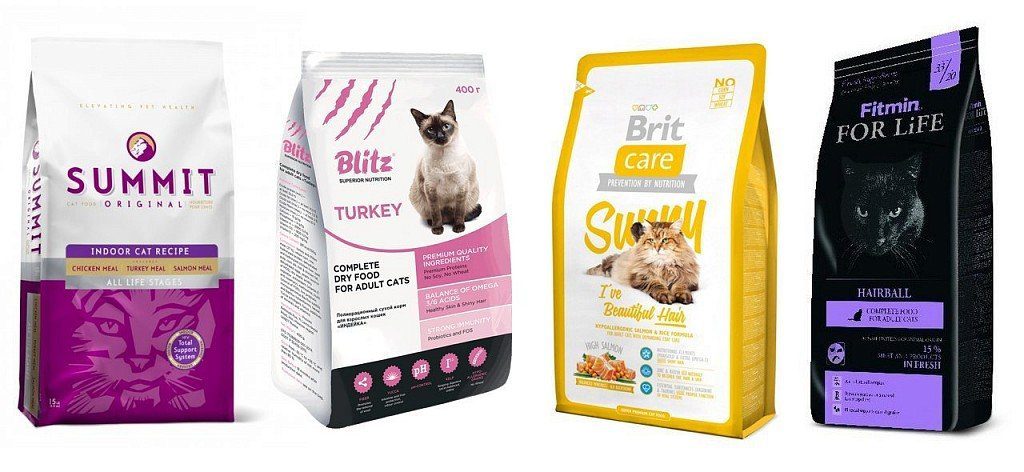
Super premium dog food made with quality ingredients and at least 25% meat
Holistic feed
Holistic food is the best you can choose for your pet. Initially, they were classified as super-premium, but today they are usually considered as a separate group. The ingredients that make up this food are of high quality and nutrition, they are similar to the food familiar to humans. This product is made using a special technology that allows you to save all the useful properties of its components, the digestibility of the feed is at least 80%.
In the composition of holistics, you will not find offal, it contains only meat (it should be fresh and / or dehydrated), or fish fillets. The meat assortment is very impressive, and not barely noticeable, as in cheap feeds. There is no place in such food for corn, wheat, wheat flour, corn gluten, potato and pea protein.
Potatoes, peas, lentils, rice are “responsible” for carbohydrates here, and the fruit, berry and vegetable group is responsible for fiber. All preservatives are natural.
Holistics are characterized by a qualitative and diverse vitamin and mineral component. We will find much more of these useful substances here than in other feeds, even those belonging to the super-premium class. Among the best brands are often named the following:
- Acana (manufactured in Canada);
- Carnilove (produced in the Czech Republic);
- Go Natural (manufactured in Canada);
- Grandorf (produced in Belgium, France);
- Farmina N&D (produced in Italy, Serbia).
The Acana brand, which often tops all kinds of ratings, is the leader in the number of positive reviews. The composition of this product is as open as possible, the percentage of all the main components is always indicated.
The cost of holistic-grade cat food can vary significantly, some of them are sold at a clearly inflated price.
On average, 1 kg of product can cost 620-900 rubles.
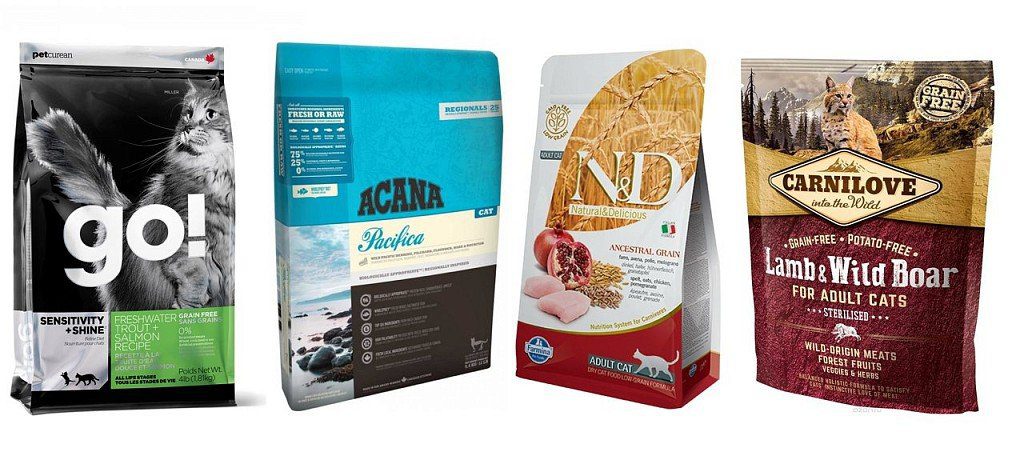
Holistic cat food is made from the highest quality ingredients, contains 65 to 80% high quality meat, no added soy, preservatives, dyes, etc.
What you need to know about the composition of feed
When choosing food for your pet, first of all, carefully read the composition of the product, remembering that the classification of the product is not always accurate. Please note that the ingredients are listed in descending order of their percentage in the product. It is desirable that the meat component be listed first, because the cat is a predator and meat-eater, he needs to eat meat regularly. If the name of the meat component in a dry product is preceded by the word “dehydrated”, you can be sure that there is exactly as much of it as indicated. The absence of a designated term indicates that the list of ingredients contains the amount of raw meat, but in reality it is at best three times less (when making dry food, the meat is evaporated). It is great if there is information about which named animal meat is present in the feed, for example, chicken meat, beef, rabbit meat, etc.
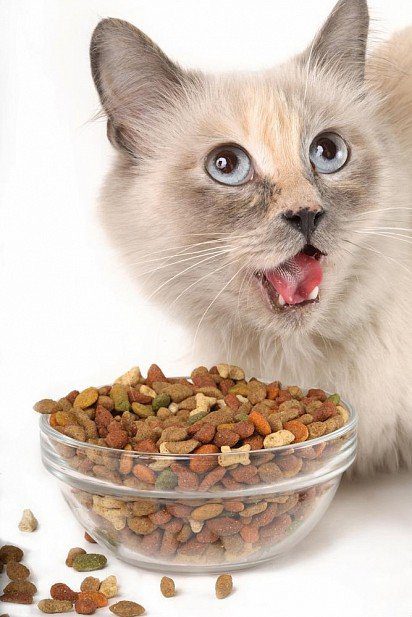
Cereals in percentage terms should not be too much, the cat does not really need them. In any case, it is desirable that grains do not occupy the first place in the list of ingredients. Rice, oatmeal are preferred, as they are absorbed by the animal’s body better than other cereals. It is good if they are presented in whole form, and not ground into flour. A good source of carbohydrates is potatoes, including sweet ones.
Look carefully at the information about by-products. If these ingredients are of high quality and healthy, for example, liver, scar, lungs, manufacturers will certainly open this information. If you see the mysterious inscription “offal of animal origin”, you can be sure that among the components there was a place for processed horns, hooves, bones, beaks, heads, ligaments, blood and other very unappetizing waste, whose useful properties are close to zero.
The presence of fruits, vegetables, lactobacilli, probiotics, plants in cat food is welcome, especially if these components are presented in a whole form, that is, not ground into powder or processed into a paste. The listed ingredients are added to food for its fortification.
Animal fats in inexpensive feeds are mostly low-grade. If the fat is of high quality, the package will indicate that it is fish or chicken (not bird!).
Undesirable fillers such as corn and wheat gluten, corn flour, cellulose powder. In many cats, they very often provoke allergies.
Preservatives and antioxidants such as BHA, BHT, ethoxyquin, propyl gallate, propylene glycol are toxic and should be kept to a minimum. Elite feeds contain safe natural compounds – vitamins E, C, citric acid, herbal extracts, oils. However, even an expensive product often uses toxic ethoxyquin, designated in the international codification as E324.
The difference between the products themselves, included in the food composition, and the results of their processing should be taken into account. For example, fish (with a specification of which one) is welcome, but fishmeal is undesirable: it is usually made from heads, tails, and bones. Eggs are preferred over powdered eggs, and whole barley and rice are healthier than crushed grains.
The presence of soy or soy protein concentrate is undesirable – this product often causes allergies in cats. Yeast is also allergenic and is added to increase the volume and give the feed an attractive aftertaste. Dyes that make food colorful can only attract the owner of the cat, they are completely useless to the animal itself.
Read the Guaranteed Analysis information on the product package for protein, fat, carbohydrate, fiber, ash, water. Please note that the best source of protein is muscle meat of chicken, beef, veal, game, eggs, and some high-quality offal.
For clarity, let’s compare the conditional composition of the most unpretentious and most expensive of dry foods. The first will contain protein and vegetable extracts, cereals (in the majority), meat (in a clear minority), meat and bone meal, mysterious offal, attractants – flavors that cats love, but are harmful to them, addictive.
In the best food you will see such appetizing products as fresh and dehydrated lamb meat, boneless duck meat, duck fat, lamb fat, herring oil, pollock fillet, herring, yellow perch, salmon. The meat is present exactly in the amount indicated on the package. In the list of ingredients you will also find eggs, red lentils, chickpeas, green peas, dried alfalfa, kelp, pumpkin, spinach greens, carrots, apples, pears, cranberries, chicory roots, dandelion, ginger, peppermint leaves, cumin seeds, turmeric , dog-rose fruit. Delicious “crackers” are characterized by a natural brown color, there is no place for dyes in such a product.
Rules for feeding cats
A cat that is accustomed to regularly eating only ready-made food should not be offered an appetizing breast or minced meat. She won’t refuse, of course, but her stomach will suffer because your treat will create an imbalance in her digestive system. You need to choose one thing – ready-made feed or natural products.
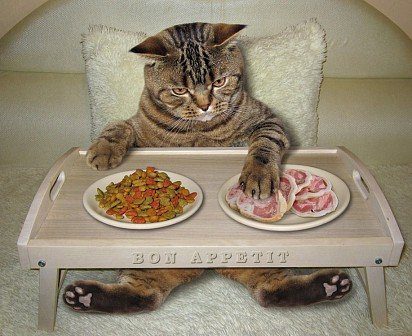
Choose one thing: ready-made food or natural
It is advisable to purchase dry and wet food from the same manufacturer, the products must belong to the same price category. You should not treat your cat with economy-class food in the morning, and in the evening with an elite-class delicacy. If you wish to change your diet, do it slowly, slowly mixing the new food into your pet’s usual food for at least a week. Increase the amount of new food by about 1/6 of the serving daily, correspondingly reducing the part of the food that you decide to discard.
If a cat, accustomed to elite food, for some reason found itself without dinner, and there is no way to buy expensive food, do not run headlong to a XNUMX-hour supermarket for an affordable cheap product – the next day the animal is guaranteed to suffer from diarrhea. Let him sleep better hungry, but healthy.
There should always be fresh water in the cat’s bowl. Please note that cats have a reduced sense of thirst. If you notice that your pet is not drinking enough, soak dry food or replace it with wet food.



